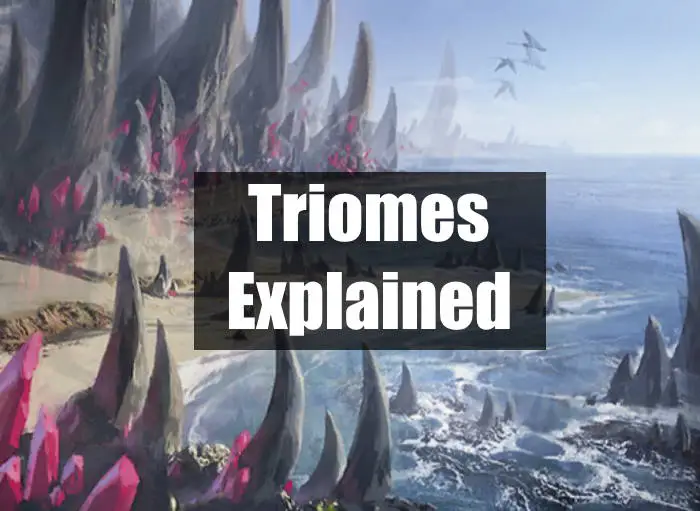Choosing the right lands is arguably the most important step to building a fun and cohesive MTG deck. With so many players building multicolor decks, it’s important to understand how triome lands function and how to get the most out of them.
Triome lands are a cycle of lands that can each produce three different colors of mana as well as have basic land types. As a downside for this versatility, these lands must enter the battlefield tapped. Additionally, Triomes all possess the “cycling” ability.
These lands are extremely useful for three and four color decks, and almost an auto-include for five-color decks. Although they aren’t the first or the only lands in MTG that can tap for three different colors of mana, they certainly are the most useful. So what exactly sets them apart from the rest? There’s a lot to unpack here; so let’s get right into it.
Table of Contents:
- What are they?
- How Do they Work?
- Are they Basic Lands?
- Can Fetch Lands Get Triomes?
- What Makes them Good?
- What Is Cycling?
- How Many Should I Run?
- Full List
- End Step
What are They?
Triomes are a cycle of “tri-lands” first introduced in Ikoria, Lair of Behemoths. Now with the release of Streets of New Capenna, the cycle is finally complete, meaning there’s one for every possible color combination.
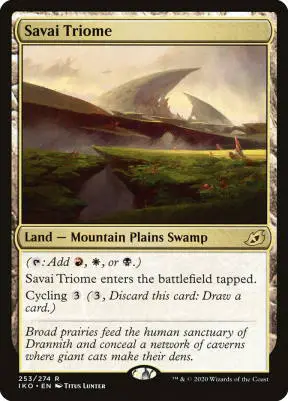
These lands can each tap for three different colors of mana. They also come with the “cycling” ability, as well as all three basic land-types associated with their respective colors. These lands can serve as powerful fixtures for the ambitious deck-builder looking to utilize spells of many different colors. However, in Magic, great power always comes at a cost.
Each of these lands must enter the battlefield tapped. This lofty downside means that players should be careful when considering Triomes for inclusion in their decks.
Naturally, not all strategies can afford to have their resources delayed. If you have the right deck for it however, the positives far outweigh the negatives.
How Do they Work?
As mentioned above, each Triome has three different basic-land types attached to it. This detail becomes quite important when you pair them with other cards that care about land types. Naturally, each Triome can tap for any one of the three colors associated with its basic land-types.
So Xander’s Lounge for example has the land type “Island Swamp Mountain” and can tap for either blue, black, or red mana, while Raffine’s Tower bears the land type “Plains Island Swamp”, and can tap for either white, blue, or black mana. Pretty great right?
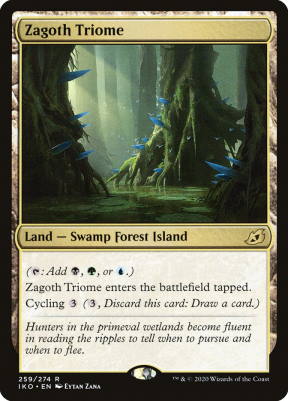
These lands aren’t without their downsides, however. Since they always enter the battlefield tapped, you can’t get any mana out of them the first turn they’re played. For most decks, being slowed down an entire turn is a major disadvantage. This is especially true in faster formats like Modern and Legacy, and less so in slower formats like Standard and Commander.
Commander is really the format that allows these lands to shine the brightest. The slower pace of Commander naturally lessens the downside of tap-lands. If your Commander deck is in three or more colors, and the triome lands are within your budget, adding them is a no-brainer.
RELATED: The Most Fun Commander Decks In MTG
Are Triome Lands Basic Lands?
In short: No, triome lands are not basic lands, though they do possess basic land types. Basic lands all have the supertype “basic” printed on them, and you can include any number of them in your decks. Triomes, however, are considered non-basic lands, and you can only include 4 copies of each. Additionally, you won’t be able to use a card like Blighted Woodland to grab a Triome, since Blighted Woodland specifies “basic”.
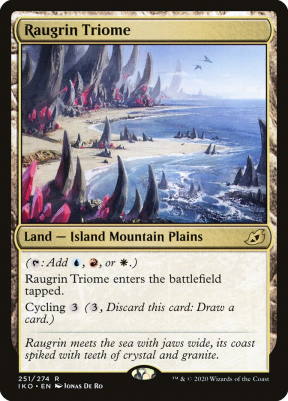
However, cards that don’t specifically mention “basic lands”, but instead refer to “basic land types” work perfectly with the Triomes. Take the card Gaea’s Might for example. If you cast Gaea’s Might with a Triome land in play, the targeted creature will get at least +3/+3.
By far the most common way to utilize the presence of these basic land-types is by pairing them with “Fetch lands”. Fetch lands are a popular cycle of lands which allows players to search their library and “fetch” any land with a certain basic land-type. Let’s delve deeper into this topic.
Can Fetch Lands Get Triomes?
That depends. Technically, a fetch land is any land that is sacrificed to put another land card from your deck onto the battlefield. Not all fetch lands are able to grab a Triome. Evolving Wilds for example can only get basic lands.
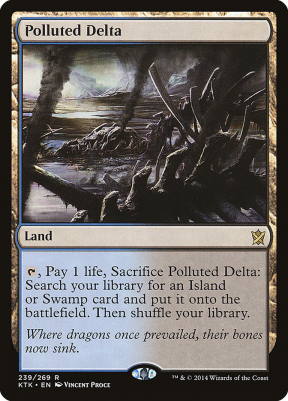
However, when most players mention fetch lands, they’re referring to the cycle originally printed in Onslaught and Zendikar. You pay 1 life, sacrifice the card, and then you get to search your library for any card with either of two basic land types. This includes triome lands.
RELATED: MTG Fetch Lands: Why Are They So Good?
What Makes them Good?
Each Triome gives you access to three different colors of mana. This alone, however, isn’t quite enough to make them great cards. After all, the first tri-lands were introduced in Shards of Alara way back in 2008.
While these tri-lands were good in their Standard block, and are still good in Commander, they see very little play elsewhere. Most competitive decks just can’t afford for their lands to consistently come into play tapped. So what makes Triomes so much better? Well, Wizards of the Coast balanced the downside of having them come into play tapped by adding two upsides. These upsides are the basic land types, which I talked about above, and the “cycling” ability.
What Is Cycling?
Cycling is a keyword ability that players can activate from their hand. You pay the activation cost and you discard the card from your hand. You then draw a new card to replace the discarded card.
While to some players this might seem underwhelming, the cycling ability vastly reduces the likelihood of a card being a bad draw. You should never underestimate the value of being able to keep a card if you need it, or trade it in for something else if you don’t.
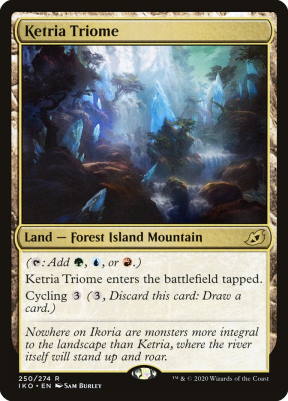
With cycling, like most abilities in Magic, there’s also plenty of possibilities for shenanigans. Take one look at the card Astral Slide and you’ll see what I mean.
New players should take note: the cycling ability can only be activated from the hand. Once a card enters the battlefield, you can no longer activate its cycling ability.
When Should I Run Triome Lands?
Now that we know how they work, let’s talk about when you should include these lands in your deck. Triomes are perfect for decks that want to use three or more colors, and decks that want to drag the game out longer and build up resources. Decks which utilize a controlling strategy are the perfect beneficiaries.
It also depends on which format you’re playing, how competitive you want to be, and what your budget is. Triomes are perfect for Commander, where the games tend to go longer.
They’re also exceptionally powerful in the Standard format. Compared to other formats, Standard has access to a limited number of strong lands, so having three different colors of mana all on one card is a huge deal.
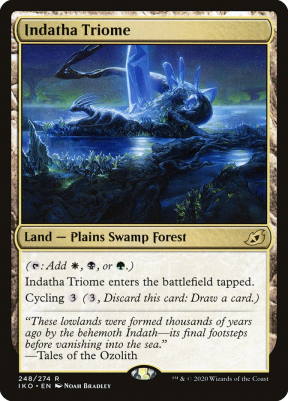
Likewise, Triomes are great in Limited. If you’re drafting a set and you see one of these tri-lands, it’s probably a great idea to snag it up and throw it in your deck.
When Should I Not Run Them?
One slight downside to these cards is their price. These lands average around $15 USD per card. While not the most expensive card in MTG, for casual players, there are plenty of cheaper alternatives. Lesser tri-lands might not have all of the upsides that Triomes have, but they’re easier on the wallet and still offer the same mana-fixing.
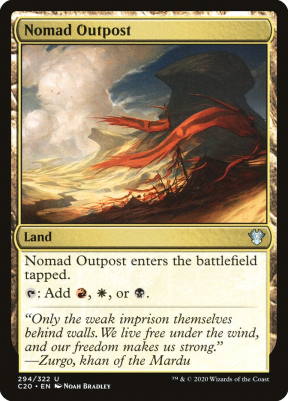
On the flip side, if you’re looking to build a competitive three, four, or five color mana-base, triome lands can actually save you money. A playset can reduce the number of shock lands, check lands, and pain lands you need.
Related: MTG Dual Lands: All Your Questions Answered
To get back on topic, however, another reason you might not want to run Triomes is if your deck is only splashing for a color. “Splashing” is when your deck primarily uses one or two colors, but you include an extra land type just to support a very few number of spells.
In this case, since you won’t need your extra color that frequently, the downside of having your lands enter tapped probably isn’t worth it.
| When to Run | When Not to Run |
| When Building Three or More Color Commander Decks | When Building Aggressive Decks That Seek to Win Early |
| When Building Three or More Color Standard Decks | When Building Casual Decks on a Budget |
| When Building Slower Decks That Don’t Care About Winning Early | When Building Three Color Decks That Only “Splash” for one of the colors |
| When Building Most 4 and 5 Color Decks Especially on a budget | When Building Decks With Less Than Three Colors |
How Many Should I Run?
So you’ve decided triome Lands are the right fit for your deck. How many should you include? That depends on a few different factors.
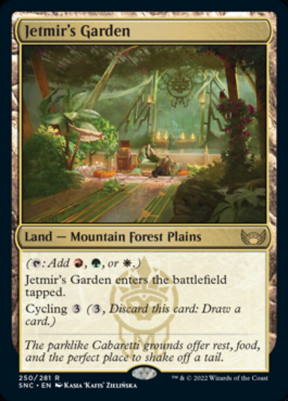
For example, if you’re building a three color Modern deck and you already have fetch lands and shock lands, just one or two copies should suffice. Building a five color Commander deck? Including one copy of several different Triomes–maybe even all ten– is a good idea.
A four-color Standard deck? In that case, you’re going to want at least a few copies of multiple different ones. It all depends on what you’re trying to do. Endless variables make supplying a cut-and-dry answer impossible.
Sculpting the perfect mana-base is an art. Don’t be afraid to experiment until you get it right.
How Many Are There?
The good news for players is that with the release of Streets of New Capenna, the triome land cycle is complete at ten lands. There is now a Triome for all possible color combinations.
RELATED: The MTG Color Wheel
Full List
Here’s the full list! It’s worth noting that the latter lands printed in Streets if New Capenna aren’t actually called “Triomes”, but are instead each named after one of the five crime lords of New Capenna.
- Indatha Triome
- Raugrin Triome
- Zagoth Triome
- Savai Triome
- Ketria’s Triome
- Jetmir’s Garden
- Ziatora’s Proving Ground
- Xabder’s Lounge
- Raffine’s Tower
- Spara’s Headquarter
End Step
Streets of New Capenna is here. The cycle is complete. Ten powerful triomes now exist, giving players the opportunity to build colorful decks without getting mana-screwed. Just so long as we’re willing to navigate the challenges of those precious lands entering the battlefield tapped.
That’s what Magic: The Gathering is all about, isn’t it? Giving and taking. Capitalizing on opportunities while mitigating the associated risks.
I hope you found this article helpful. If you can make them work for you, these lands offer a freedom and consistency rivaled by few other cards.
I hope to see you all out there on the streets of New Capenna. Maybe if we’re lucky, we’ll be powering our spells from the mighty seats of one of the five Capennen crime lords.
